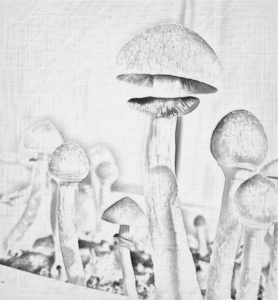Psilocybin Mushrooms (Psychedelic Mushrooms, Magic Mushrooms)
Ocean, Middlesex, Union, Mercer & Monmouth County, New Jersey Psilocybin Mushrooms Drug Possession and Distribution Defense Attorneys
Drug Facts About Hallucinogenics: Psilocybin Mushrooms (Psychedelic Mushrooms)
Street names: Magic mushrooms, mushies, caps, shrooms, boomers
Drug Classification: While psychedelic mushrooms are not specifically named in U.S. federal law, the active chemicals Psilocybin and Psilocin are both Schedule I substances in the United States and are illegal to possess under any circumstances without a DEA license.
General Drug Information
 Psilocybin mushrooms are fungi containing the hallucinogenic compounds psilocybin and psilocin. Psychedelic mushrooms were used during rituals and ceremonies by indigenous tribes in Central and South America. There are a little less than 200 species of psilocybin mushrooms, most of which are small and tan or brown in color. This makes them easily mistakable not only with non-psychoactive mushrooms but also with poisonous or toxic mushrooms. Their consumption can therefore be quite hazardous.
Psilocybin mushrooms are fungi containing the hallucinogenic compounds psilocybin and psilocin. Psychedelic mushrooms were used during rituals and ceremonies by indigenous tribes in Central and South America. There are a little less than 200 species of psilocybin mushrooms, most of which are small and tan or brown in color. This makes them easily mistakable not only with non-psychoactive mushrooms but also with poisonous or toxic mushrooms. Their consumption can therefore be quite hazardous.
How Mushrooms Are Taken
Mushrooms can be eaten by themselves, with other food, or brewed into a tea to drink. They are most often dried, but can be eaten wet as well (users typically increase the dosage by 10 when eating wet mushrooms). Their onset of effects depends on metabolism and how recently the user has eaten other food.
Low doses of mushrooms produce feelings of relaxation that are sometimes compared to the effects of marijuana. Higher doses produce more intense LSD-like effects including visual hallucinations, time dilation, and spiritual experiences.
Side Effects
Physically, users may feel cold, numb, or otherwise uncomfortable. Nausea and vomiting are common, as are gas and stomach discomfort. Pupil dilation is also a common physical effect. The mental effects of mushrooms range from feelings of stimulation, increased artistic sense, and emotional sensitivity to giddiness, euphoria, and sudden realizations to paranoia, frightening hallucinations, and the return of repressed memories or psychological crises. This third set of effects is often referred to as having a “bad trip.” These experiences can be so intensely frightening that they can leave users with permanent psychological or emotional problems. The risk of having a negative experience is increased if someone is having personal problems or if they have a history of schizophrenia. These people should absolutely not ingest mushrooms, as their resulting mental state will be particularly unstable and carries an extremely high risk of going bad. Some people report having flashbacks of past mushroom experiences even long after the effects of the drug have worn off. These flashbacks can occur suddenly and without warning.
Addiction
Mushrooms are not physically addictive, though they can be habit forming and some users turn to them to escape their everyday lives. Tolerance builds up rapidly, often requiring a dose twice as high to achieve the same effects. This lasts around 5 days and also causes cross-tolerance with LSD and DMT.
Dangers
The main danger lies in mistaking poisonous or toxic mushrooms for psychedelic mushrooms. Do not go out into the forest looking to pick “magic mushrooms,” as you may very well collect mushrooms that only cause vomiting and diarrhea with no psychoactive effects. In worse cases, these mushrooms could cause liver damage, kidney failure, respiratory depression, loss of limbs, and death. Moldy mushrooms or mushrooms that are old and have gone bad can also be toxic and should not be consumed.
Overdose
Risks of mushroom overdose also vary greatly from strain to strain. Some are almost impossible to overdose on; others can cause life-threatening heart or liver failure.
Sources:
- http://www.erowid.org/plants/mushrooms/mushrooms_basics.shtml – Mushroom Basics
- htp://dancesafe.org/drug-information/magic-mushrooms – Magic Mushrooms
- http://www.drugfree.org/drug-guide/mushrooms – Psilocybin Mushrooms Drug Guide
- http://www.erowid.org/plants/mushrooms/mushrooms_effects.shtml – Side Effects of Magic Mushrooms
- http://www.thegooddrugsguide.com/mushrooms/dangers.htm – Dangers of Mushrooms
- http://www.thegooddrugsguide.com/mushrooms/addiction.htm – Addiction to Hallucinogenic Drugs – Magic Mushrooms
